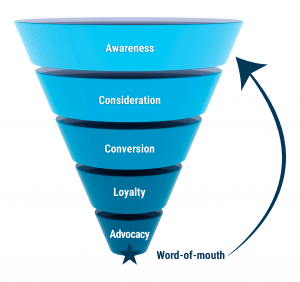You’ve probably seen some permutation of the age-old marketing funnel before:

It’s pretty straightforward. In general, the traditional customer buying process has long been:
- Awareness: Prospective customers become aware of your product/service brand.
- Consideration: They enter a consideration phase, including your brand in a consideration set along with multiple other brands. During this phase, they weigh the pros and cons of each brand’s offering to determine which they like best, or whether to purchase at all.
- Conversion: After considering the different brands, they convert into customers (assuming they don’t abandon the funnel at this stage).
- Loyalty: If customers have a positive experience, they would continue to purchase your product/service as loyal customers.
- Advocacy: Through this ongoing relationship, customers become advocates for your brand, creating word-of-mouth, and thus increasing awareness—bringing the whole funnel full circle.
The idea behind the marketing funnel is that of the thousands or millions of prospects that may become aware of you, only a certain percentage of those would include you in their consideration set. Then, only a certain percentage of those would purchase. Then, only a certain percentage of those purchasers would convert into repeat purchasers. Then only a certain percentage of those would be truly delighted enough to become advocates. So of those thousands or millions of people who might become aware of you, only a fraction end up purchasing, and an even smaller number would end up advocating for your brand.
The problem with trying to apply this traditional funnel model to today’s marketplace is its over-emphasis on awareness. Granted, if you are a large brand with a stable conversion rate demonstrating that 8% of people aware of you will purchase your brand, then it makes sense to focus on building awareness. But this type of traditional thinking is very much catered to big brands with sufficient marketing budget to truly attack on the awareness front. A Fortune 500 company appealing to the mass audience can afford to build top-of-the-funnel awareness with a super bowl advertisement, but for the vast majority of companies outside of the mass market elite there are now superior options for driving marketing ROI than launching expensive awareness campaigns. Essentially, the funnel has turned into more of a maze over the past decade for most businesses. The following are just a couple illustrative examples of how and why the funnel has changed:
- Consumer Empowerment: For some consumers, awareness and consideration have merged into a single phase. With the rise of online reviews, many consumers won’t buy anything without first researching reviews. In these instances, prior awareness (while not entirely valueless) means much less because the consumer takes an active role in building their consideration set.
- For example: Bose has achieved massive awareness in the audio world; it’s one of the leading electronics brands in terms of awareness. This was traditionally extremely advantageous for Bose, and they invested heavily on awareness advertising to earn that level of awareness. Today, however, a consumer is very likely to research reviews on headphones, for example, before making this purchase. Through this process, they are likely to discover other brands they never heard of, or are less familiar with, that spend far less on advertising (such as Klipsch, Sennheiser, Bowers Wilkins, Skullcandy, etc.). If these alternative brands are well-reviewed, there’s a good chance that they will be purchased instead of Bose headphones. After all, consumers can (and should!) trust the word of other consumers more than the claims a company makes about itself. This example also speaks to the power and importance of inbound marketing – making sure you are positioned online to get found when consumers are actively searching for what you provide.
- Consumer Elusiveness: More and more consumers are becoming impervious to commercials. They tune out, turn off, skip, or fast-forward commercials when they see them. Or utilize alternative media technologies that don’t expose them to commercials in the first place. As a result, gaining awareness is increasingly difficult and expensive. Consumers have effectively de-emphasized the role of awareness in the buying process, preferring an active – rather than passive – purchase experience.
- Marketing Funnel Fluidity: Some people skip awareness and consideration altogether, jumping right to purchase (example: stumbling across a great review for a blender, and then impulse purchasing online when they were never in the market for a blender in the first place).
So, what does this all mean for you?
Well, the good news is that – if you are not among the Fortune 500 elite – you can compete on a more level playing ground with larger brands. What does Nike’s massive awareness mean if a prospective buyer does a Google search for “best running shoes” and comes across a strong set of reviews for Asics? Answer: Not a whole heck of a lot. Focus on (and invest in) creating a stellar product/service, increasing customer satisfaction, and using a smart combination of inbound and traditional marketing strategies to make sure you get found online during the consumer search process. Keep in mind that many activities within the funnel now take place online through forums, review sites, e-commerce sites, blog articles, social media platforms, Google searches, and more. Make sure that you are where you customers likely are—in the digital world searching for the products or services that you offer.


Leave a Reply